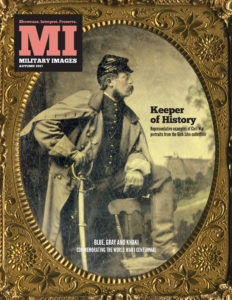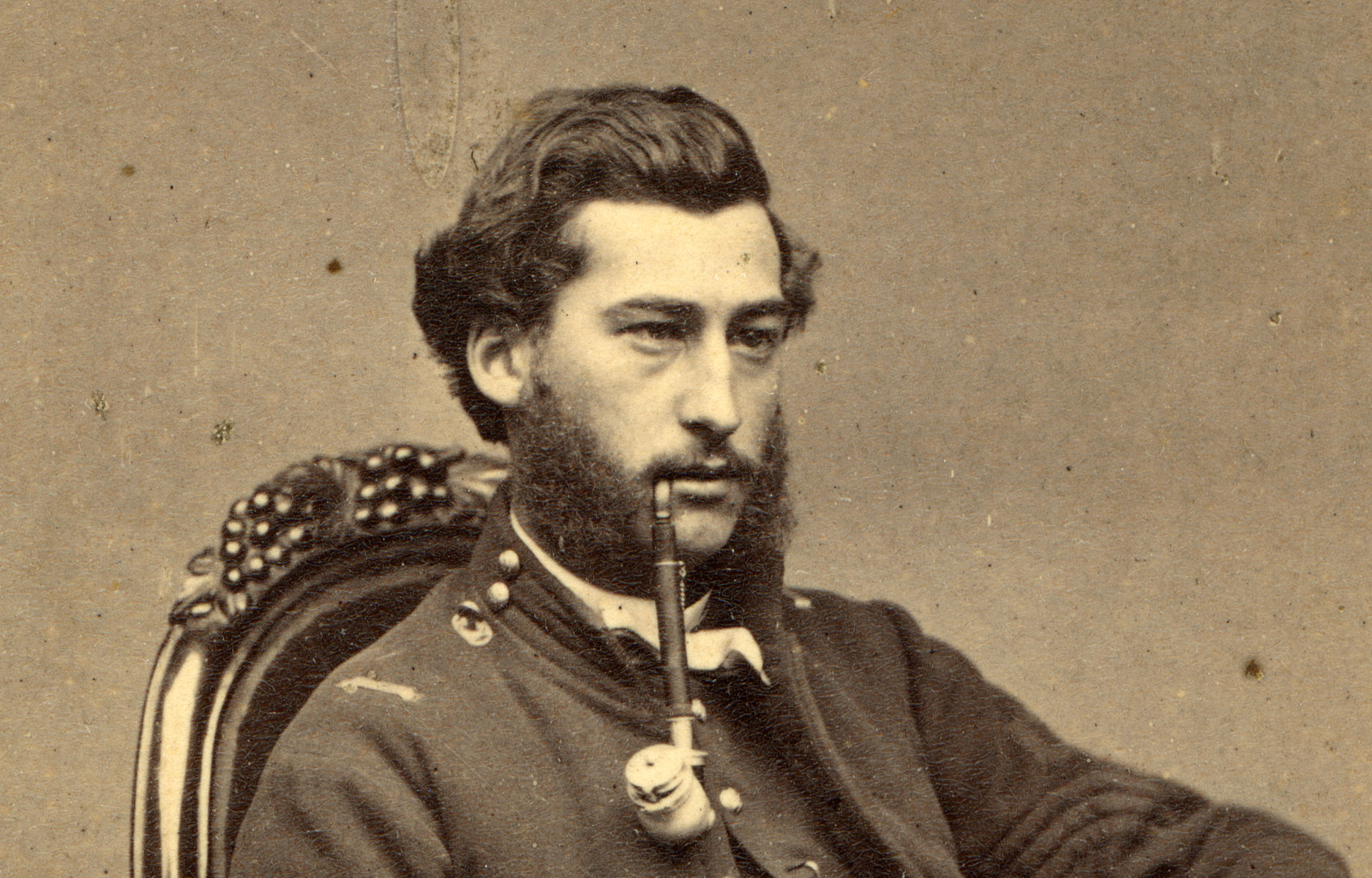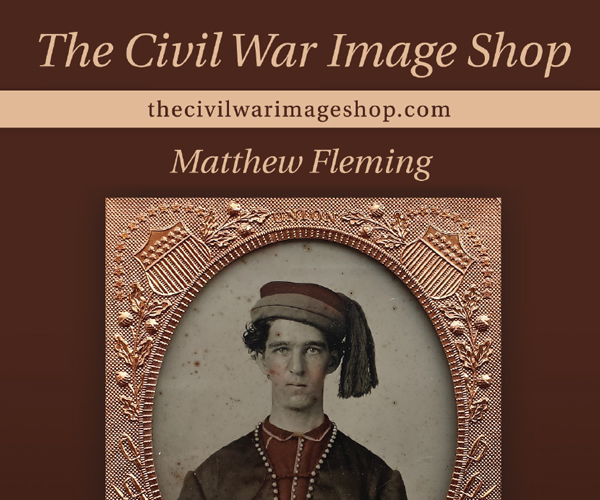 The complete issue
The complete issue
Vol. XXXV, No. 4
(80 pages)
Print edition: Visit our store to check availability
Digital edition: Visit JSTOR.org to purchase
Subscribe to MI ($24.95)
Explore the MI Archives: Browse | Advanced search | Tutorial
Inside
Cover image
A quarter-plate tintype from the Rich Jahn Collection pictures a dashing cavalry officer staring into the distance.
Download (free)
Table of Contents (p. 1)
Download (free)
Editor’s Desk (p. 2)
In “On Blue, Gray and Khaki,” the editor observes the commemoration of the centennial of World War I and reflects on how the timeline for MI has shifted from 1839 to 1939 when the magazine was founded to today’s primary coverage of the Civil War period.
Download (free)
Mail Call (pp. 3-4)
Feedback includes praise for the last issue, information about image quality and submissions, and the debut of CivilWarPhotoSleuth.com at the Gettysburg Show.
Download (free)
Passing in Review (p. 6)
Roger D. Hunt’s latest in the Colonels in Blue series profiles commanders in Illinois, Iowa, Minnesota and Wisconsin.
Download (free)
Antebellum Warriors (p. 8)
A half-plate daguerreotype by Mathew B. Brady from the National Portrait Gallery Collection pictures John Pelham, the West Point cadet who reluctantly resigned to join the Confederate army after his home state of Alabama seceded from the Union. This image is part of a current National Portrait Gallery exhibit.
Most Hallowed Ground (p. 10)
Henry Meigs Meade, the nephew of Maj. Gen. George G. Meade and second cousin of Quartermaster Gen. Montgomery Meigs, had a tough time as a paymaster in the navy. Unaccounted funds and other irregularities resulted in his dismissal, but he was later allowed to resign.
Photo Sleuth by Kurt Luther (pp. 12-13)
Kurt identifies an officer, Capt. Thomas Whiting of the 89th Illinois Infantry, using traditional research methods and CivilWarPhotoSleuth.com.
The Honored Few (pp. 14-15)
In “Escape after Spotsylvania,” we meet Lt. Col. Edmund Rice of the 19th Massachusetts Infantry. Though he received the Medal of Honor for his actions during the Battle of Gettysburg, the story about his capture at Spotsylvania and eventual escape is less known—and illustrated with an albumen print of him with three fellow escapees.
Blue, Gray & Khaki (pp. 16-26)
A survey of 22 portraits of doughboys, Union veterans and Confederate veterans. Included in the group are two Civil War veterans still in uniform during World War I: William West Grant, who served in Brig. Gen. James H. Clanton’s Artillery Battery (Alabama) and Walter H. Thomas Jr. of the 29th Maine Infantry. Other identified soldiers are also included.
Doughboy: Origins of a Classic Americanism (p. 27)
Though “doughboy” was popularized during World War I, the origin of the word as a military term is disputed, with several explanations emerging over the years. This story examines six newspaper references from 1853-1865.
Keeper of History: Images from the Rich Jahn Collection (pp. 29-39)
Jahn, a respected collector, takes a long view of the hobby, “We never own these images. We are only the keepers of history during our tenure of collecting. Someday someone else will be looking at these soldiers and saying, ‘I wonder where this image came from. Who had it before me?’” A selection of his best images is included.
Unsung Pioneer Photo Collector: Samuel Crocker Lawrence and the Medford Collection by Ronald S. Coddington (pp. 40-47)
Quiet, unassuming and wealthy, Samuel Lawrence commanded the 5th Massachusetts Infantry at the First Battle of Bull Run, where he suffered a serious wound that ended his military service. He would go on to amass a collection of 3,680 Civil War photographs, which was rediscovered in 1990 after years of being forgotten.
Hagerstown’s Durable Man: A Marylander’s half century of military service spanned four wars by Stephen R. Bockmiller (pp. 48-51)
German immigrant George Leonard Fisher started his military service in 1862 with the 7th Maryland Infantry and ended it in 1917 as a drill instructor to troops recruited to fight World War I. The text is illustrated with seven portraits of Fisher.
Yankee & Doughboy: A trove of newly discovered photographs documents a father and son by Aaron D. Purcell, with images from the Jeremiah T. Lockwood, Jr. Collection, Special Collections, Virginia Tech (pp. 52-54)
Jeremiah Talcott Lockwood, Jr. was sent to the local insurance office to pay a bill on behalf of his father, and he wound up enlisting in the Union army. His life story, illustrated with eight portraits that span his long life, is included here.
Following the Torn and Bloodstained Colors: John Michener’s Civil War Odyssey by Dan Clendaniel (pp. 56-59)
Michener, an officer in the 85th Pennsylvania Infantry, had his first encounter of the war with Peace Democrats in the Keystone State before he ever stepped a foot into the Confederacy. He would go on to see his share of action in Southern territory. Captured in a skirmish on the outskirts of Savannah, Ga., he spent months in prison, where he was used for a time as human shield. The image is illustrated with his wartime portrait.
Camp Photographers: Pictures by the thousands by Ron Field (pp. 60-63)
According to the author, “Virtually every military encampment had a travelling photographer nearby or within its limits during the Civil War. This was particularly true in the North, where photographic chemicals and supplies were readily available throughout the conflict.” What follows is an exploration of how camp photographers got started, details of the studies and prop weapons, and information about Confederate picture-makers.
The Making of Major Hay: A rare portrait of Lincoln’s private secretary is an artifact from a special wartime mission by Paul Russinoff (pp. 65-67)
A rare image of President Abraham Lincoln’s personal secretary dressed in a senior officer’s uniform and seated with a friend is a token of friendship. It is also a relic tied to an Executive Order from the White House that sought to end the war in 1864 by bringing Confederate states back into the Union under the auspices of a deceptively simple idea. Lincoln’s “Ten-Percent Plan” was not well received—and neither was Hay.
Reminiscences of an Exiled Marylander: The life and services of McHenry Howard by Evan Phifer (pp. 68-70)
Howard, the grandson of “Star-Spangled Banner” author Francis Scott Key, left his Maryland home to fight for the South. He served in a variety of role and fought in numerous battles, which he duly noted in his autobiography, Recollections of a Maryland Confederate Soldier and Staff Officer Under Johnston, Jackson and Lee.
Uniforms & History by Michael J. McAfee (p. 71)
In “The Zouave Mystique and the New York State Militia,’” Mike observes that Elmer E. Ellsworth and his Chicago United States Zouave Cadets probably had limited effect on New York militiaman during the Cadet’s 1861 tour of the Empire State. The 13th New York Militia Infantry is a notable exception.
Scalpels to Swords: West Virginia physicians who became combat commanders by Richard A. Wolfe (pp. 72-73)
The author profiles three medical men who became effective battlefield commanders, including Henry Capehart of the 1st Cavalry, Thomas Maley Harris of the 10th Infantry and Irish-born Joseph Thoburn of the 1st Infantry.
Stragglers: Distinctive Images from MI contributors (pp. 75-77)
Seven images are included, and all are of Southern origin. None of the men are identified, but there are clues that may lead to a positive identity by an alert subscriber.
Sutler’s Row (p. 79)
The Last Shot (p. 80)
Corporal David Henry Bennett of the 28th New York Infantry left a note tucked into his photograph case that explains why he wears a Confederate cap. It also suggests he had a premonition of his own battlefield death. In fact, he was killed at Antietam.






























